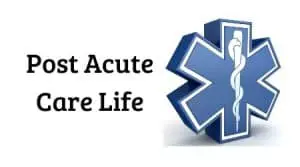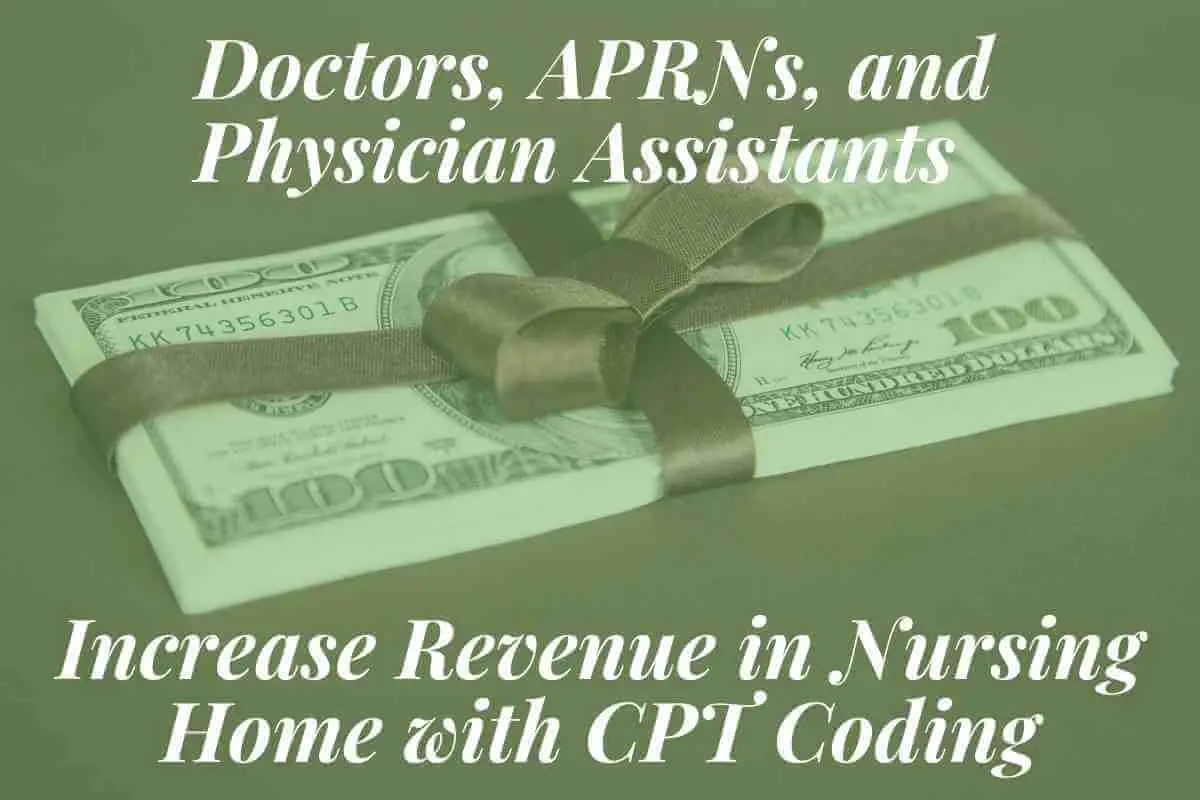One of the most common questions we receive when training nurse practitioners in the nursing home is, “how do I maximize the level of billing for the visits.”
The best way to maximize reimbursement for your medical visits is to follow Medicare guidelines.
1. Bill for the level of work that you do
2. Document all the components for the level of visit
3. Make sure your visit meets the requirements for the level of visit you are billing.
4. Do not under code because you are worried about an audit
5. Utilize add-on codes such as advanced care planning when medically appropriate
Unfortunately, there isn’t some magic way to increase the level of visit. Yes, some providers bill higher-level visits on average. There really should be more medically complex patients to justify the higher level if this is the case.
The truth is, many providers under-code the visit. Most likely, the under coding occurs because of a fear of failing an audit of their notes. However, if you properly document the level of risk and meet the components of the exam, you will pass an audit with the insurance companies.
Medical decision making for determining the level of visit
It would be best if you made sure that your medical decision-making is determined on two out of three MDM elements. Your progress note needs to clearly show the medical decision-making done in the assessment and plan.
According to the American Medical Society, Physician/other qualified health care professional time includes the following activities, when performed:
- Preparing to see the patient (e.g., review of tests)
- Obtaining and/or reviewing separately obtained history
- Performing a medically appropriate examination and/or evaluation
- Counseling and educating the patient/family/caregiver
- Ordering medications, tests, or procedures
- Referring and communicating with other health care professionals (when not separately reported)
- Documenting clinical information in the electronic or another health record
- Independently interpreting results (not separately reported) and communicating results to the patient/ family/caregiver
- Care coordination (not separately reported)
All visits will require a history and physical exam. The extent of history and physical examination is not an element in selecting the level of codes.
Number of Medical Issues and Problems Addressed
One of the main things that determine the visit level is the number and complexity of the addressed problems. Include all of the issues that are addressed in your progress note. This will help increase the level of medical complexity.
Therefore it is important to document the ICD 10 codes for all the symptoms and actual problems addressed. If the patient has fatigue, make sure to include that in your diagnosis list. Just remember that all the symptoms are not necessarily “conditions.”
When you have multiple symptoms, there is a higher likelihood that the patient is experiencing something that is higher risk. If there is a higher risk to the patient, then the medical decision-making will be higher.
If you don’t document the symptoms, how will MedicareMedicare and the insurance companies know what is going on?
What should be documented to meet the criteria for higher visits:
One component of determining the level of the CPT code is determining the risk for complications. Determining the risks includes the morbidity or mortality of patient management.
According to the AMA, the level of risk is based upon the consequences of the problem(s) addressed at the encounter when appropriately treated.
Risk also includes MDM (medical decision making) related to the need to initiate or forego further testing, treatment, and/or hospitalization.
Remember that the patient can still be at high risk even if the possible outcome isn’t death. The patient could end up with a life-altering event.
The alternative could be true with serious events that don’t necessarily lead to life-altering events or death as a risk factor. An example is certain cancers treatments have low-risk side effects (serious illness, low-risk profile for the treatment) even though it’s treating a very serious condition.
Documenting medications that require monitoring to support higher-level visits
You should always document medications that require monitoring by the physician or practitioner in your notes when appropriate. Many drugs can have serious side effects with toxic levels. When you identify these side effects it can increase the level of visit.
Unfortunately, just documenting monitoring for therapeutic effect only does not increase the level of the visit. Even monitoring of glucose levels could be interpreted as monitoring for therapeutic effect.
You want to focus your documentation on avoiding the adverse outcomes of the medication, such as severe hypo or hyperglycemia.
What doesn’t count towards increasing the level of visits?
Just because you document something doesn’t mean it increases the level of complexity of the visit.
Simply documenting that the patient is going to dialysis and will manage labs doesn’t add a layer of complexity. However, your progress note needs to tell the story, so it is good to include these points.
Charting a bunch of labs and studies that are not related to the problem or reason for the visit do not count towards the level of complexity.
Many medical providers feel the need to add a bunch of “fluff” to their progress notes. Just because you use many words in your note doesn’t mean the visit is more complex.
Documenting a review of systems and physical exam components that have nothing to do with the reason for the exam also doesn’t increase the level.
For instance, you see the patient because they have an ingrown toenail but do a full system review. No extra credit for documenting on all the exam components when they are not required.
Sometimes documenting the above information is warranted when it shows the provider’s thought process and how they came to a decision regarding the diagnosis and plan of care.
What are some of the CPT codes for nursing home visits?
How can you know how to maximize billing without understanding the requirements for each of the CPT codes in the nursing home. If you are going to bill for each level, you will need to know the criteria for each.
There are three CPT codes used for admits to the facility. With medical visits, these visits are done by the doctor assigned to the patient. They include 99304, 99305, and 99306.
CPT Code 99304 is a detailed visit with straightforward medical decision-making.
How long is a CPT code 99304? 25 minutes
CPT Code 99305 is a detailed visit with straightforward medical decision-making.
How long is a CPT code 99305? 35 minutes
CPT Code 99306 is a detailed visit with straightforward medical decision-making.
How long is a CPT code 99306? 45 minutes
CPT Code 99307: is a straightforward medical exam with a problem focus. The patient is either stable, recovering, or improving.
How many minutes does a 99307 visit take? 10 minutes total time.
CPT Code 99308: is for patients that are not responding or have minor complications. This CPT code is an expanded problem visit and is focused.
How many minutes does a 99308 visit take? 15 minutes of total time.
This CPT code is used for patients who inadequately respond to treatment or have developed a minor completion.
CPT Code 99309: is used for patients with significant complications or new problems.
How many minutes does a 99309 visit take? 25 minutes of total time.
This CPT code is used for patients requiring a detailed medical examination with moderate complexity. The patient has developed a significant complication or a significant new problem.
CPT Code 99310: is for a Significant new problem requiring immediate attention, high complexity visits. CPT code 99310 is for unstable patients or patients that have developed a significant new problem requiring immediate medical attention.
How many minutes does a 99310 visit take? 35 minutes
CPT Code 99315: This is a discharge code used for visits that take less than thirty minutes.
CPT Code 99316: This is a discharge code used for visits that take more than thirty minutes.
CPT Code 99318: is used for the annual exam of patients ad is a comprehensive exam with low to moderate decision-making complexity. The patient is usually stable, recovering, or improving.
How many minutes does a 99318 visit take? 30 minutes.
If you are looking for a comprehensive book that will go over the current medical CPT coding guidelines, check out this book on amazon. #ad
Advance Directive Exam CPT Code 99497:

One of the main ways to optimize your billing is to bill for CPT code 99497. This is a great code for getting paid for the work you do regarding code status and advance directive discussions.
CPT code 99497 is used for any of your Medicare patients requiring this discussion.
You should bill for this CPT code whenever you discuss and explain code status with the patient and family. When there is a need to have family meetings, change in health status, end of life discussions can all warrent this CPT code.
You can utilize this CPT code more than once a year if needed, even if they don’t change the status. If there is a medically appropriate reason for having this discussion, then consider utilizing 99497.
Remember that you need to spend a minimum of 15 minutes regarding the care and discuss advance directives to bill this CPT code. This code is good for up to 30 minutes, and if you take longer, you can also utilize CPT code 99498 as an add-on code. You will need a minimum of 16 minutes past the first 30 minutes documented to bill a 99498.
For example, the patient is declining and currently full code status. The condition requires that you call the family to see if the POA can change code status to DNR or hospice. After all this work, even if they don’t change the code status, you can still bill CPT code 99497.
Billing for time in the nursing home
Many providers leave money on the table by not considering the time in their coding for visit level. You can increase the visit level by incorporating the extra time it takes for coordination, education, and counseling of the patient and family.
When you are using “time” to justify the visit level, make sure the time is warranted for the problem being addressed. You can not include the time that is not related to the visit.
The are many blogs and youtube videos that can help you with billing for expanded time.
“When physicians use “time” for determining the level of visit, their documentation must support time spent with the patient.
For example, you wouldn’t expect to see a 45-minute visit for an otherwise healthy patient being seen for acne.
When reviewing documentation for time, you must verify that you are consistently documenting the total time for the encounter.
Time may only be used to select the other E/M services level when counseling and care coordination dominate the service.
When you add time to the note as justification of the higher visit, document the reason for the extra time and include “greater than 50%” when appropriate.
Conclusion:
When you get to the bottom of coding visits and enhancing your revenue, it really boils down to what MedicareMedicare and the insurance companies will allow.
There are no tips that fall outside the rules because they only set you up for failing an audit and getting yourself in trouble.
Following the rules of Medicare does not mean that you shouldn’t take advantage of all the areas that Medicare allows. It would help if you always billed for the appropriate visit level, utilize add-on codes, and document accordingly.
References:
https://insideangle.3m.com/his/blog-post/focus-on-e-m-coding-new-year-new-resolutions-new-outpatient-office-visit-coding-guidelines/ Retrieved October 20, 2021
2021 American Medical Association https://www.ama-assn.org/system/files/2019-06/cpt-office-prolonged-svs-code-changes.pdf Retrieved October 20, 2021
https://www.cms.gov/medicare-coverage-database/view/article.aspx?articleId=57724&ver=4 Retrieved October 22, 2021
https://www.cgsmedicare.com/partb/mr/pdf/99308.pdf Retrieved October 23, 2021


